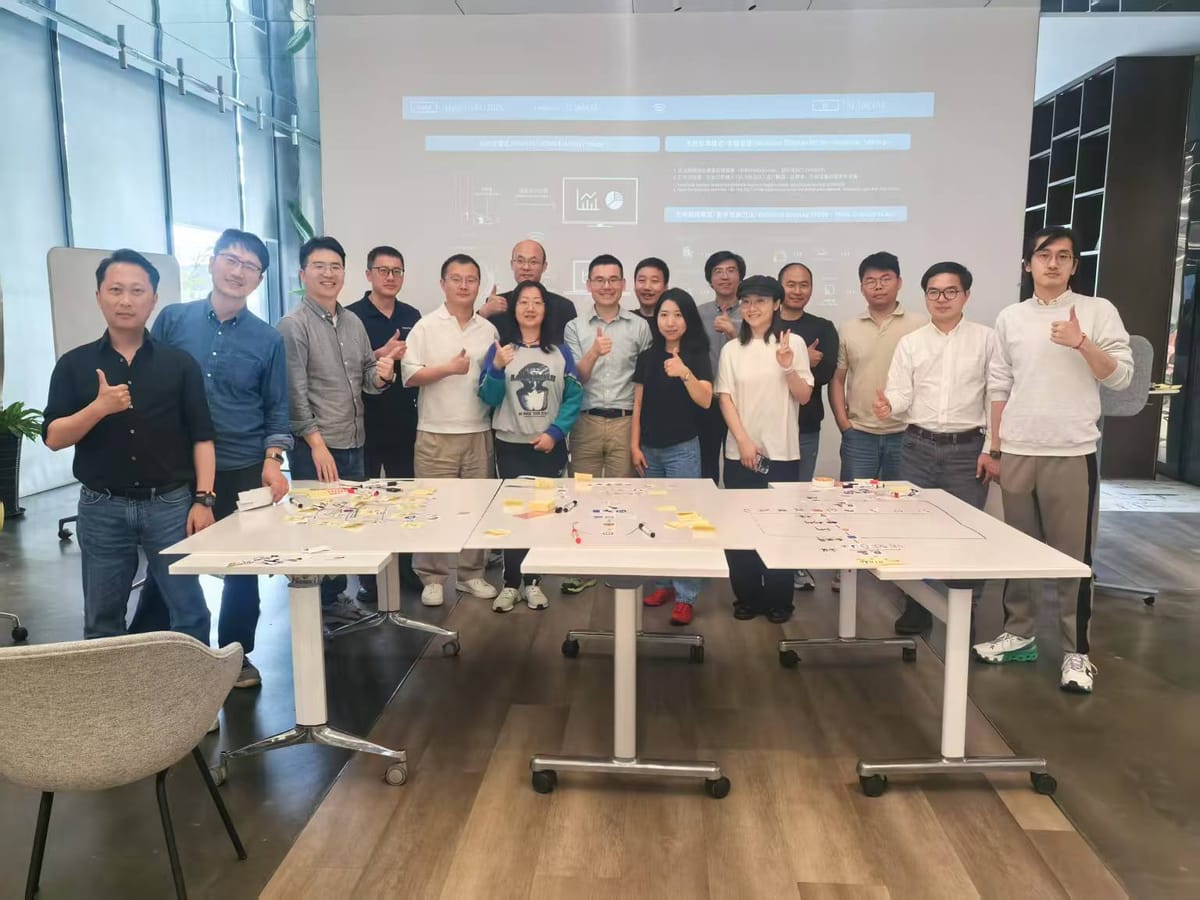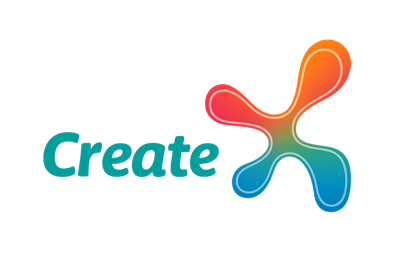#4 Workshop In Shanghai How to Use AI to Reshape Team Collaboration and Professional Growth?” 如何利用 AI 重塑团队合作与专业成长:上海工作坊回顾
从设计思维出发,探索 AI 如何重新定义团队协作与专业成长。本次工作坊聚焦多元创意与实践,呈现三支小组的创意原型分享。

Workshop Recap: “How to Use AI to Reshape Team Collaboration and Professional Growth?”
On April 9 in Shanghai, the “How to Use AI to Reshape Team Collaboration and Professional Growth?” workshop brought together participants from different industries and backgrounds. Leveraging design thinking methodologies—from user insights to rapid prototype validation—the workshop fully explored AI’s potential in future work and team collaboration. Below is a highlight recap of the event and the final presentations of the three teams.
Workshop Overview
- Date: 2023/04/09 (13:00 - 17:00)
- Location: B3-A201 M Space, No. 388, North Chengdu Road, Huangpu District, Shanghai
- Theme: How to Use AI to Reshape Team Collaboration and Professional Growth?
Agenda:
- 13:00 - 13:30: Opening & Ice-breaking
- 13:30 - 15:00: Introduction to Design Thinking & Group Formation
- 15:00 - 16:30: Team Brainstorming & Rapid Prototype Building
- 16:30 - 17:00: Group Presentations & On-site Feedback
Design Thinking: A Human-Centered Path to Innovation
This workshop centered on Design Thinking, emphasizing starting from the real needs of users or audiences, rapid iteration, and prototype validation. The key stages included:
- Empathize: Understanding and observing the true experiences of target users
- Define: Extracting needs from insights to pinpoint the core issues
- Ideate: Conducting brainstorming and concept exploration using diverse methods
- Prototype: Turning ideas into initial visual or interactive prototypes
- Test: Optimizing through evaluations and feedback from users or team members
Final Presentations by the Three Teams
At the conclusion of the workshop, the three teams showcased their innovative prototype concepts through live demonstrations and discussions. Below are the creative highlights and key ideas from each team.
1. “Smart Workstation” — Integrated Hardware and AI Solution
The first team started with a physical device and developed a “Smart Workstation” that combines AI with hardware to upgrade both office and lifestyle scenarios across multiple dimensions:
- Form and Function:
- A table + display + mobile stand, complete with wheels for easy movement
- An integrated AI module offering voice recognition, environmental monitoring, and health detection functions
- Eye-tracking technology to prevent distractions (“slacking off”) and monitor fatigue levels, prompting timely rest
- Expandable “Arms”:
- A six-axis robotic joint that automatically adjusts the display angle and can even perform simple actions
- Possibility for future expansion into culinary, card-dealing entertainment, and other rich scenarios
- Multi-Scenario Integration:
- Adaptable for students doing homework, office workers at their jobs, and entertainment venues offering gaming experiences
- Enhanced social features with ambient lighting and voice assistants
“We want to integrate all office, entertainment, and health management functions into one mobile workstation to truly enhance the work experience of both individuals and teams.”
— Representative of Team One
2. “Abby” — Multifunctional AI Companion for Home & Work
The second team focused on the “all-in-one AI assistant,” conceptualized as “Abby.” It is designed to offer comprehensive service and companionship for individuals, families, and various institutions:
- Core Positioning:
- Suitable for a wide range of users: from children and the elderly to professionals
- One-button switching among multiple roles such as tutor mode, health reminder mode, and emotional companion mode
- Product Form:
- Constructed with special materials and a wheel design, making it lightweight and portable for various environments
- Can be summoned or commanded via voice, WeChat, smart speakers, and other channels
- Global Market & Philanthropic Vision:
- After production along domestic supply chains, the product unexpectedly sparked overseas interest, leading to an explosive surge in orders
- Profits will be reinvested into philanthropy, supporting remote areas and underprivileged groups
- Scenario Coverage:
- Online education for children, medication reminders for the elderly, and emotional communication among family members
- Remote communication and support in business settings
“Abby stands by like a family member—taking care of your children and elders, and providing emotional support whenever you need it.”
— Representative of Team Two
3. AI-Driven Logistics and Emotion Management System
The third team concentrated on “enterprise logistics and emotion management” by proposing a data management system that integrates AI with daily employee workflows. It not only addresses administrative tasks like travel and ticketing but also uses multiple sensors (including sound and vital signs) to detect employee emotions and provide tailored care measures:
- Multidimensional Emotion Sensing:
- Collecting and analyzing data to assess employees’ current emotional states (e.g., anxiety, irritability, fatigue)
- Intelligent Care and Assistance:
- Offering electronic pets or AI chat tools to help relieve stress
- Suggesting time off or family communication if low mood persists
- Dynamically adjusting incentives (bonuses or learning opportunities) based on performance and state
- Feedback and Iterative Database Updates:
- Continuously collecting employee usage and feedback data to refine the system’s decision-making models, delivering more personalized emotion support and logistics management
“Our system not only enhances work efficiency but also gives employees a greater sense of being cared for, helping them maintain a healthy physical and mental state at work.”
— Representative of Team Three
On-site Interaction and Feedback
After the teams presented their prototypes, a vibrant discussion took place. Key points of focus included:
- Data Privacy and Ethics: How to protect privacy when collecting employee emotional and behavioral data
- Feasibility and Cost: The practicality of hardware development, mass production, and entering international markets
- User Acceptance and Trust: Building trust in AI services regarding emotions, privacy, and system decision-making
- Balancing Philanthropy and Commerce: How to balance profitability with social responsibility as the products scale up
Conclusion and Outlook
This workshop combined “Design Thinking + AI” to let participants experience the whole process—from discovering needs to rapid prototype development. The teams’ presentations showcased the boundless possibilities of applying AI in work and life, while also highlighting the need for further discussion and iteration on practical implementation and ethics.
Looking ahead, we hope to see more teams and individuals join this exploratory journey. Together, we can ponder how AI can further humanize work, help teams unlock their potential, and simultaneously uphold ethics and social responsibility. Let’s continue to experiment and iterate toward a smarter, warmer, and more sustainable future!
Interested in Learning More?
- Follow upcoming workshop previews and recaps
- Discover more industry case studies on the integration of Design Thinking and AI
- Feel free to leave a message or contact us—we look forward to sparking more creative ideas with you!
A big thank you to all participants and volunteers. We also look forward to exploring the endless possibilities of “How to Use AI to Reshape Team Collaboration and Professional Growth” together in more cities and across more fields in the future!
在 4 月 9 日上海举办的「如何利用 AI 重塑团队合作与专业成长?」工作坊中,来自不同行业与背景的参与者齐聚一堂,借助设计思维方法论,从用户洞察到快速原型验证,充分挖掘了 AI 在未来工作与团队协作中的潜能。以下是本次工作坊的精彩回顾及三支团队的最终展示内容。
工作坊概览
时间: 2023/04/09(13:00 - 17:00)
地点: 上海市黄浦区成都北路 388 号 B3-A201 M Space
主题: 如何利用 AI 重塑团队合作与专业成长?
Agenda
- 13:00 - 13:30 工作坊开场 & Ice-breaking
- 13:30 - 15:00 设计思维方法导入 & 小组组建
- 15:00 - 16:30 团队头脑风暴 & 快速原型搭建
- 16:30 - 17:00 小组成果分享 & 现场反馈
设计思维:以人为本的创新之路
本次工作坊以设计思维(Design Thinking)为核心,强调从用户或受众的真实需求出发,快速迭代、原型验证。通过以下关键阶段,帮助参与者聚焦痛点并创造可行的解决方案:
- 同理心(Empathize): 了解并观察目标用户的真实体验
- 定义问题(Define): 从洞察中萃取需求,明确核心痛点
- 创意发散(Ideate): 利用多元化方法进行脑暴与概念探索
- 原型制作(Prototype): 将想法转化为初步可视化或可交互的雏形
- 测试与反馈(Test): 通过用户或小组间的测评进行优化
三个团队的最终分享
在本次工作坊尾声,三支团队分别带来了他们的创新概念原型,并进行现场演示与讨论。以下是他们的创意亮点与思路。
一、「智能工作台」——集成化硬件与 AI 解决方案
第一支团队从实体设备出发,打造了一款「智能工作台」,通过 AI 与硬件结合,实现办公与生活场景的多维度升级:
- 形态与功能:
- 桌子+显示屏+可移动支架,带有轮子可随时移动
- 内置 AI 模组提供语音识别、环境监测、健康检测等功能
- 通过眼球追踪防止用户“摸鱼”,并可监测疲劳程度,及时提醒休息
- 可拓展的“触角”:
- 六轴机器人关节可用于自动调节显示器角度、甚至执行简单动作
- 未来可能扩展到烹饪、发牌娱乐等更丰富的场景
- 多场景融合:
- 学生做作业、职场打工人办公、娱乐场所游戏等
- 搭配氛围灯光、语音助手等增强社交属性
“我们想把所有办公、娱乐和健康管理功能融合到一个可移动的工作台上,真正提升个人与团队的工作体验。”
—— 第一支团队代表
二、「Abby」多功能 AI 家庭&工作伙伴
第二支团队主打「全能 AI 助手」,以「Abby」为概念原型。它针对个人、家庭和各类机构提供全方位的服务和陪伴:
- 核心定位:
- 适用人群广泛:从小孩、老人到职场人士
- 家庭教师模式、健康提醒模式、情绪陪伴模式等多种角色一键切换
- 产品形态:
- 特殊材质+轮式设计,轻巧易携,适合各种使用环境
- 可用语音、微信、智能音箱等多渠道呼唤或发指令
- 全球市场与公益愿景:
- 产品在国内供应链完成后意外地在海外引发兴趣,订单量爆发式增长
- 收益将回馈公益事业,资助偏远地区、弱势人群
- 场景涵盖:
- 孩子的在线教育、老人药物提醒、家庭成员情感交流
- 商业场合的远程沟通与支持
“Abby 像家人一样时刻待命,帮你照顾孩子、照顾老人,也能在你需要的时候提供情绪支持。”
—— 第二支团队代表
三、AI 后勤与情绪管理系统
第三支团队聚焦于「企业后勤与情绪管理」,提出了一个整合 AI 与员工日常工作流程的数据管理系统。它不仅关注差旅、订票等行政事务,还能通过多种传感器(包括声音、体征等)捕捉员工情绪并提供对应的关怀措施:
- 多维度情绪感知: 通过数据采集与分析,判断员工当下的情绪状态(焦虑、烦躁、疲惫等)。
- 智能关怀与辅助:
- 提供电子宠物或 AI 聊天工具,帮助疏解压力
- 若情绪持续低落,可建议休假或与家人沟通
- 依据绩效与状态动态调整激励措施,包括奖金或学习机会
- 反馈与数据库迭代: 不断收集员工使用和反馈数据,完善系统的决策模型,给出更个性化的情绪支持与后勤管理。
“我们的系统不仅提高工作效率,也提供给员工更多‘被关怀’的体验,帮助他们在工作中保持健康的身心状态。”
—— 第三支团队代表
现场互动与反馈
在三支团队分享完原型后,现场展开了热烈讨论。大家纷纷关注:
- 数据隐私与伦理: 如何在搜集员工情绪、行为数据时保护隐私?
- 可行性与成本: 硬件开发、规模化生产、跨国市场进入的可行性
- 用户接受度与信任: 使用 AI 服务时,用户对情感、隐私和系统决策的信任度如何建立?
- 公益与商业平衡: 当产品规模化后,如何兼顾盈利与社会责任?
结语与展望
本次工作坊通过「设计思维 + AI」的组合,让大家体验到从需求洞察到快速原型搭建的全过程。三支团队的分享充分展现了 AI 应用在工作与生活中的无限可能,也提示了在落地与伦理方面需要更多思考和迭代。
未来,我们期待更多团队和个人加入到这个探索行列,一起思考人工智能如何进一步人性化、帮助团队释放潜能,同时兼顾道德与社会责任。让我们在不断地试验和迭代中,为更加智慧、温暖且可持续的未来共同努力!
有兴趣了解更多?关注后续工作坊预告及回顾获取更多设计思维与 AI 结合的行业案例欢迎留言分享你的想法或与我们联系,期待与你一起碰撞更多创意火花
感谢所有参与者和志愿者的付出,也期待未来在更多城市与更多领域一同探索「如何利用 AI 重塑团队合作与专业成长」的可能性!


